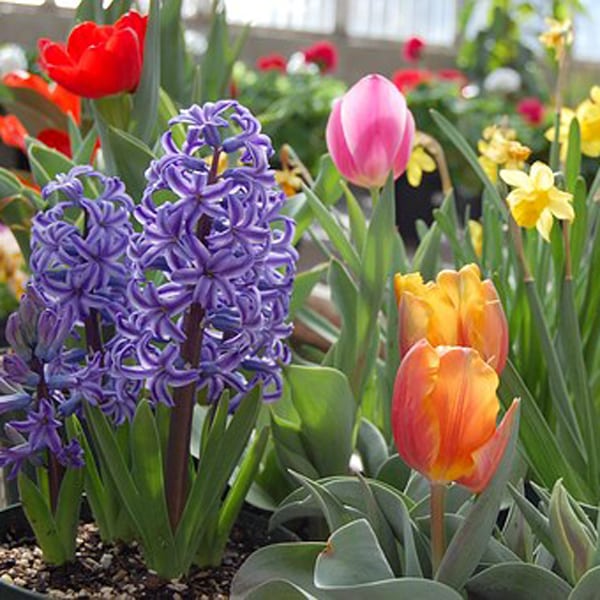
As the days are getting colder and shorter most people don’t think about spring, but now is the time to plant spring bulbs. Tulips are a spring favorite but there are so many more colorful options than just tulips. Daffodils. Alliums, Crocus, Narcissus (Daffodils), Hyacinth, Muscari (Grape Hyacinth), Galanthus (Snowdrops), Hyacinthoides (Spanish bluebells), Scilla, all make good addtions to the garden.
All are great additions to the spring garden and fill a particular time during the spring season. Bulbs are not fussy, but there are a few considerations. First of all let’s talk general culture. All bulbs need a freely draining location that does not collect water. Bulbs HATE to be in standing cold water. It just makes them rot. Most need a decent amount of sun to fully mature for the following year.
When planting it is a good time to add fertilizer to the bulbs’ hole. Most bulbs benefit from fertilizer every year, especially hyacinths. It is good to fertilize them right after the bloom to ensure a full stalk of flowers the following year. Bone meal or Bulb-Tone are both good choices.
Since most people think tulips for spring color first I will address a couple of common issues with them. First of all is that squirrels love tulips. They can eat them as fast as you plant them. One good way to keep them out of your bulbs is to sprinkle a generous amount of cayenne pepper around your freshly planted bulbs. Wire cages will also slow down squirrels but this method is difficult at best and can be bother some when planting other perennial or annuals in the same location. Also tulips will stop producing over the years. If you want to be sure of a tulip display its best to dig up you old bulbs and replace with new every year. Species tulips do last longer but not guaranteed for years of color.
If you want an easy and satisfying spring bulb display consider narcissus (daffodils). They come in many shades of yellow, cream, and pinks. They will naturalize over the years so your display will get larger over the years and squirrels and deer do not eat them. Narcissus are poisonous to them as well as cats and dogs. Do not let your dogs eat daffodil bulbs.
There are many other spring and early summer bulbs to consider. Galanthus (Snowdrops), Scilla and Muscari are all great additions to the garden that naturalize over the years. Summer color can be had by using alliums with there big heads of purple and pink are a real show stopper I the summer beds. Alliums are also avoid by deer and squirrels.
Companion plants that work well with bulbs are Hermerocallis (Day lily), Iris German, Grasses, Cranesbill, Veronica, Nepeta, Sedum “Stonecrop”, Phlox paniculata, Peony, Hibiscus moscheutos, Perovskia atriplicifolia (Russian sage), Hosta, Dicentra (Bleeding hearts), Iberis (Candytuft) & Myosotis (Forget me nots). All of these perennials have the same culture as bulbs and enjoy the same locations.
When designing you bulb gardens think about the style of garden you what to create. Do you like formal with straight rows and columns? Maybe you prefer an American prairie style with large drifts of color or just a few random groups in the garden just to show that spring is on its way. No matter your style remember more is more with bulbs! Have fun and invite spring into you yard with bulbs.
By Jack Wagner









